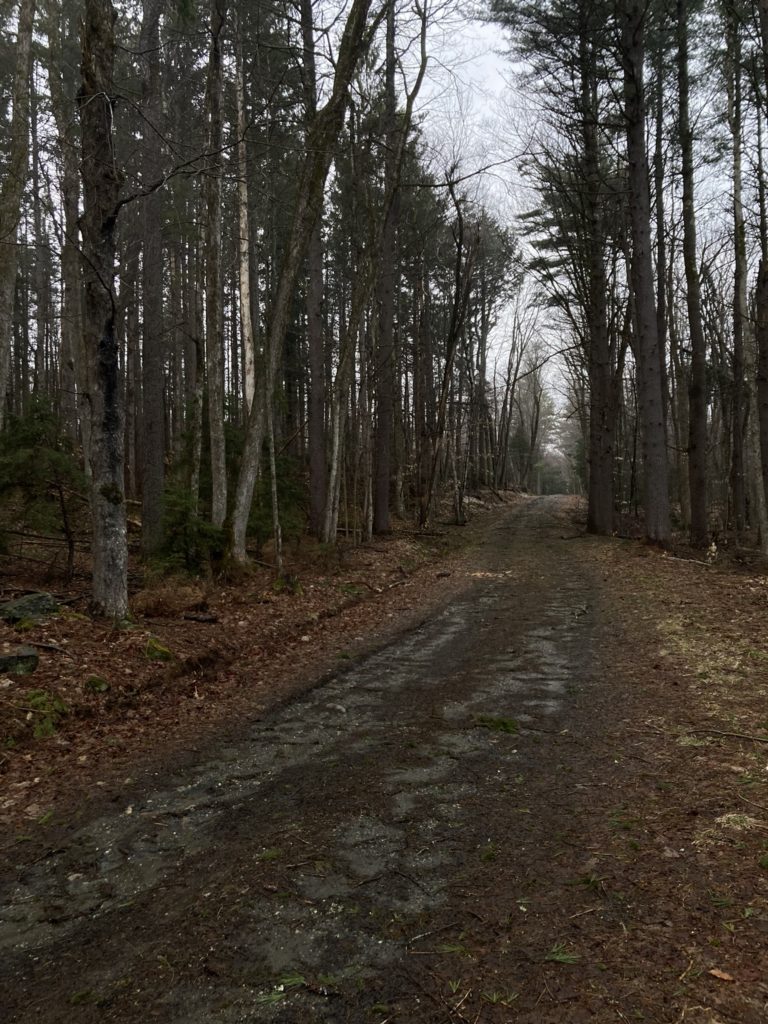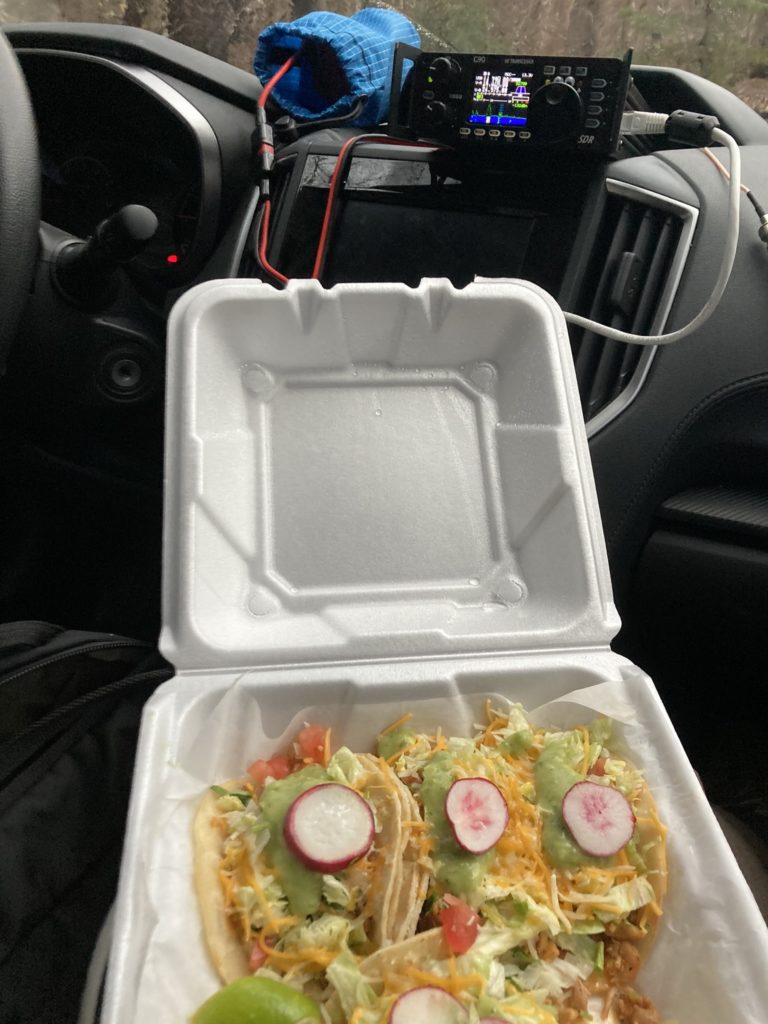TacoPOTA: H.O. Cook State Forest
April 14th 2024
I was struggling to get out of the house this Sunday due to ever-present AI (autoimmune illness) issues, but wanted tacos from a favorite taco truck of mine in the Big Town about 20 minutes away; they have the best tortillas and their hot salsa is legit. A wonderful thing that has been happening here these past few years is that the prophecies have started to come true: a taco truck is indeed on every corner! A beautiful morning transitioned into a rainy afternoon and evening, with temperatures hovering around 50 F / 10 C, which made it even harder to want leave the house. I work from home, so getting out of my little tourist village and seeing people, and getting out into nature, on the weekends feels critical for mental health. At the encouragement of some fellow hams on Mastodon, I went and picked up those tacos, and then decided I would do a Parks On The Air (POTA) activation in one of my favorite places to operate: H.O. Cook State Forest (US-4761) on the Massachusetts-Vermont Border.
H.O. Cook is great for a few reasons: it’s about a half hour drive from my house, and is in the middle of almost nowhere, so it’s very RF quiet with few if any other people: there are no trails, just logging roads. It’s very easy to operate from a folding chair out of the back of my car, or from within my car in inclement weather. Given that I use wire antennas for HF, I am also not really causing environmental damage (certainly less than the logging here) or disturbing anyone by using trees to support my antenna: a practice that isn’t really advisable in many, if not most, parks. But just as important, the operating position I use there is at a local height of land: about 1700 ft / 518 m above sea level with no close-by higher topography getting in the way.

Because it’s a barely trafficked park, it also means the roads going through there are a bit rough, and not really maintained. My last activation here, a few weeks ago, saw several branches down across the main road going through the forest, and one tree blocking the road entirely. Today, most of the larger woody debris was cleared up, or could be driven around. The road surface itself, however, was both mud-season rutted and half-washed out from some intense rain we’ve had during the later winter this year. Suffice to say, while navigable, it’s not a great thing for the underside of my low clearance car. I didn’t get a chance to check the other end of the road I normally use to enter, as it was washed out pretty heavily from last summer’s very intense rainstorms and floods (something happening here with increasing frequency due to a certain well-documented global scientific phenomenon). While arguably not navigable by anything lower than a truck last year, I didn’t want to chance that bit of road this soon after this past winter, before a grader could get in there. A neighbor of mine was the highway boss of the town this park is in and was responsible for maintaining this road. He passed away suddenly and unexpectedly a few weeks ago, and I couldn’t help but think of him while slowly crawling my car around the washouts; our last bike ride together was on this very road.
I got to my usual pulloff, coincidentally under a stout, high branch of a red oak, ate my chicken and al pastor tacos, and proceeded to set up. Because it was late in the day and various fediverse hams had been talking about cruddy propagation this weekend, I opted to use my 40m dipole that I made out of 16 AWG speaker wire with a kludgy homemade binocular choke. I can operate on 40m and 20m with a nice, predictable gain maxima broadside to the dipole, and on 15m with a more X-shaped gain pattern, with maxima at about 45 degrees broadside. I threw my arborist throw line over a branch, hoisted the feedpoint up about 30 feet, and set up the legs along the NNE-SSW oriented woods road in a shallow inverted V: the other nice thing about this operating position is I can set up a dipole along the road and not have to worry too much about weaving a longer antenna through tree branches.

15 meters was dead, which was disappointing as my antenna was oriented with some high gain towards Europe in that band. I had come to the park, also, with the intent of getting more local contacts, so switched to 40 meters. The band was extremely noisy with near constant static crashes, rendering it practically unusable for me: the Xiegu G90 I use has a noise blanker, but I don’t really know how to use it, and have heard it’s not particularly robust. In this case, it did little to cancel out the noise that was making it very difficult to copy what I could hear. I reluctantly settled on 20m. I say reluctantly because, typically on weekends, it’s a jam-packed band and hard to find a clear frequency. There’s almost always some legal limit station with splatter that appears 2 KHz up from me, and/or ear damaging malicious interferance from sad POTA-hating hams (seriously, what is up with these miserable people?).
This time, however, 20m was downright pleasant: no malicious QRM! The propagation was also phenomenal! Three DX contacts: Two Italy and one Jamaica, and a ton of coast-to-coast QSOs with operators in the Pacific Northwest U.S. (all faint but we made it work!) in addition to the Southwest U.S. Super strong signals both ways into Ohio, Indiana, Oklahoma, and other parts of the near Midwest, and the ever present QSOs with what is beginning to feel like my POTA family in the Appalachian and Ozark South. I’m always impressed with what one can do with just 20W, elevation, and a efficient antenna, even though being at the height of the sun cycle has more to do with it than anything else.
As it got dark, I realized I had forgotten a headlamp, so started writing QSO’s by the light of my half-charged phone. I had also forgotten my 20+ year old cheap LCD Timex Expedition, set to UTC time, that I use for ham radio, so I was juggling my phone’s flashlight, my notebook, and the phone itself to check the time and to log each QSO. It was getting late, and though it was a 3 day weekend here in Massachusetts it was still a Sunday night and pouring rain; time to pack it in and go home to sleep.
Due to years of fieldwork and camping in remote wilderness, in addition to living in the sticks for much of my adulthood, I’m someone who generally feels safe alone and out in the woods, even at night. But sometimes the New England woods after dark, well… the land has witnessed a lot of trauma due to colonization, and, as much as folks from the South may not want to hear it, topographically and geologically (and, I’d argue, culturally in many respects) these hills and mountains here are also part of the Appalachians. I was tired, my mind in a state where I knew it could play tricks, and the Blair Witch Project is still fresh in my mind 25 years later. I didn’t want to linger in these woods too long lest I hear disembodied whistling or something worse. I struck down my antenna very quickly by the light of my phone, packed it up, and raced out of there. I’ll come back.
All in all, 70 SSB QSOs in about 2 hours with several park-to-parks, including one in Harpers Ferry: which felt like it should have been in the skip zone for these conditions. Not too shabby! And because I decided to stick around after 8pm local time (00:00 UTC), I got credit for 2 activations because it rolled over into a new UTC day.

(Apologies for the lack of captions on the first two images: For some reason, WordPress isn’t allowing me to caption them. the first is of a dirt woods road going through a New England hardwood forest. It is cloudy and rainy and damp, and the woods look anemic and austere. The second photo is from the inside of a car, looking towards the dashboard from the front passenger seat. A styrofoam tray of tacos sits in the photographers lap, while a Xiegu G90 HF transceiver sits on the top of the dash.)